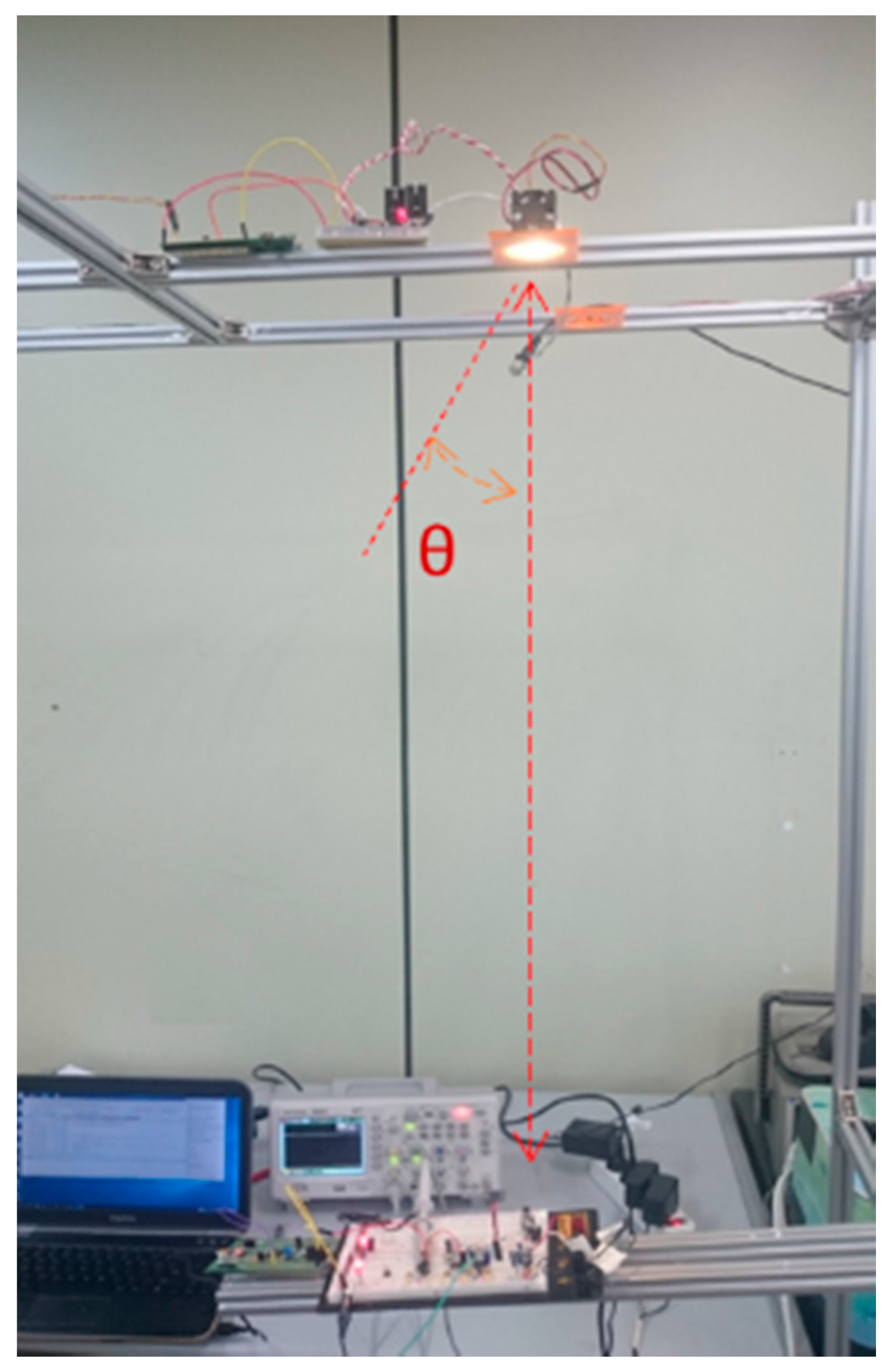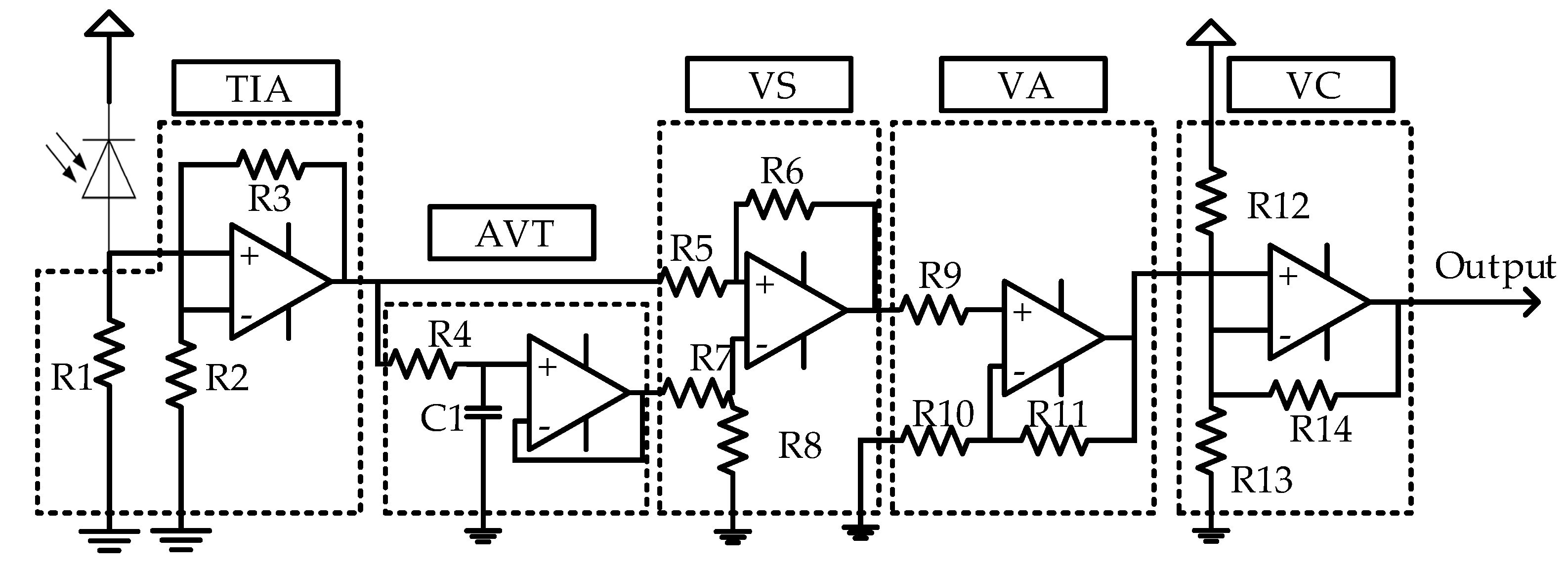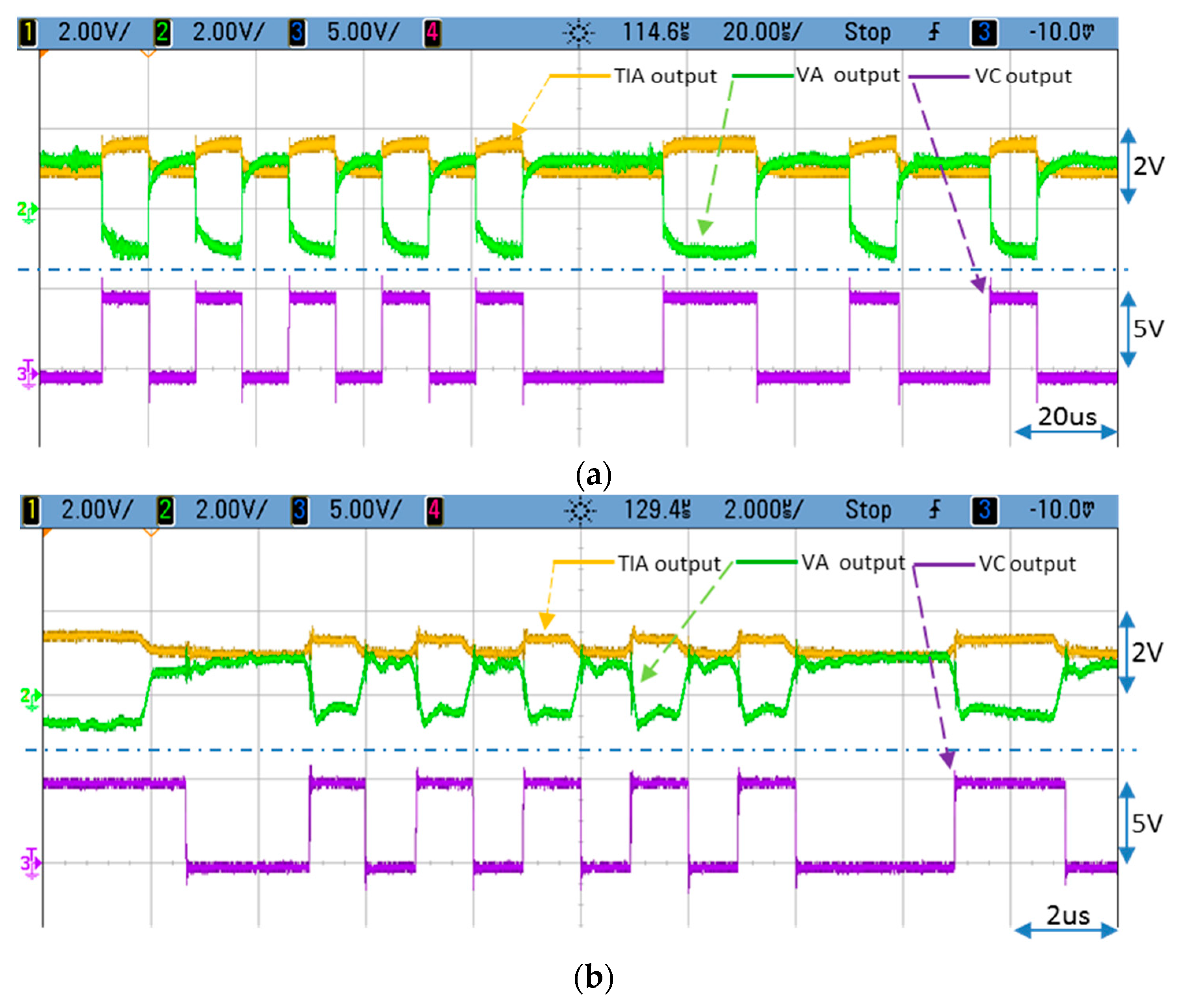Ambient Light Rejection Using a Novel Average Voltage Tracking in Visible Light Communication System
Abstract
:Featured Application
Abstract
1. Introduction
2. SNR Analysis of the VLC System with Light Interference
2.1. Optical Wireless Channel
2.2. Novel Receiver Design
3. Experiment and Results
3.1. SNR Distribution Experiment
3.2. Proposed Receiver Performance
4. Conclusions
Acknowledgments
Author Contributions
Conflicts of Interest
References
- Karunatilaka, D.; Zafar, F.; Kalavally, V.; Parthiban, R. Based Indoor Visible Light Communications: State of the Art. Commun. Surv. Tutor. 2015, 17, 1649–1678. [Google Scholar] [CrossRef]
- Do, T.-H.; Yoo, M. An in-Depth Survey of Visible Light Communication Based Positioning Systems. Sensors 2016, 16, 678. [Google Scholar] [CrossRef] [PubMed]
- Grobe, L.; Paraskevopoulos, A.; Hilt, J.; Shulz, D.; Lassak, F.; Hartlieb, F.; Kottke, C.; Jungnickel, V.; Langer, K.-D. High-speed visible light communication systems. IEEE Commun. Mag. 2013, 51, 60–66. [Google Scholar] [CrossRef]
- Rajagopal, S.; Roberts, R.D.; Lim, S.-K. IEEE 802.15.7 visible light communication: modulation schemes and dimming support. IEEE Commun. Mag. 2012, 50, 72–82. [Google Scholar] [CrossRef]
- Niaz, M.T.; Imdad, F.; Kim, H.S. Power Consumption Efficiency Evaluation of Multi-User Full-Duplex Visible Light Communication Systems for Smart Home Technologies. Energies 2017, 10, 254. [Google Scholar] [CrossRef]
- Sklavos, N.; Hübner, M.; Goehringer, D.; Kitsos, P. (Eds.) System-Level Design Methodologies for Telecommunication; Springer: New York, NY, USA, 2014. [Google Scholar]
- Chvojka, P.; Zvanovec, S.; Haigh, P.A.; Ghassemlooy, Z. Channel Characteristics of Visible Light Communications within Dynamic Indoor Environment. J. Lightwave Technol. 2015, 33, 1719–1725. [Google Scholar] [CrossRef]
- Pathak, P.H.; Feng, X.; Hu, P.; Mohapatra, P. Visible Light Communication, Networking, and Sensing: A Survey, Potential and Challenges. Commun. Surv. Tutor. 2015, 17, 2047–2077. [Google Scholar] [CrossRef]
- Komine, T.; Nakagawa, M. Fundamental Analysis for Visible-Light Communication System using LED Lights. IEEE Trans. Consum. Electron. 2004, 50, 100–107. [Google Scholar] [CrossRef]
- Ong, Z.; Chung, W.-Y. Long Range VLC Temperature Monitoring System Using CMOS of Mobile Device Camera. IEEE Sens. J. 2016, 16, 1508–1509. [Google Scholar] [CrossRef]
- Rachim, V.P.; Jiang, Y.; Lee, H.S.; Chung, W.-Y. Demonstration of long-distance hazard-free wearable EEG monitoring system using mobile phone visible light communication. Opt. Express 2017, 25, 713–719. [Google Scholar] [CrossRef] [PubMed]
- Do, T.-H.; Yoo, M. Performance Analysis of Visible Light Communication Using CMOS Sensors. Sensors 2016, 16, 309. [Google Scholar] [CrossRef] [PubMed]
- Huynh, P.; Yoo, M. VLC-Based Positioning System for an Indoor Environment Using an Image Sensor and an Accelerometer Sensor. Sensors 2016, 16, 783. [Google Scholar] [CrossRef] [PubMed]
- Huynh, P.; Do, T.-H.; Yoo, M. A Probability-Based Algorithm Using Image Sensors to Track the LED in a Vehicle Visible Light Communication System. Sensors 2017, 17, 347. [Google Scholar] [CrossRef] [PubMed]
- Li, H.; Chen, X.; Huang, B.; Tang, D.; Chen, H. High Bandwidth Visible Light Communications Based on a Post-Equalization Circuit. IEEE Photon. Technol. Lett. 2014, 26, 119–122. [Google Scholar] [CrossRef]
- Lim, K.-H.; Lee, H.-S.; Chung, W.-Y. Multichannel Visible Light Communication with Wavelength Division for Medical Data Transmission. J. Med. Imaging Health Inform. 2015, 5, 1952–1957. [Google Scholar] [CrossRef]
- Tan, Y.Y.; Chung, W.-Y. Mobile health monitoring system through visible light communication. Biomed. Mater. Eng. 2014, 24, 3529–3538. [Google Scholar] [PubMed]
- Wu, F.-M.; Lin, C.-T.; Wei, C.-C.; Chen, C.-W.; Huang, H.-T.; Ho, C.-H. 1.1-Gb/s White-LED-Based Visible Light Communication Employing Carrier-Less Amplitude and Phase Modulation. IEEE Photonics. Technol. Lett. 2012, 24, 1730–1732. [Google Scholar] [CrossRef]
- Hussein, A.T.; Elmirghani, J.M.H. Mobile Multi-Gigabit Visible Light Communication System in Realistic Indoor Environment. J. Lightwave Technol. 2015, 33, 3293–3307. [Google Scholar] [CrossRef]
- Wang, Z.; Yu, C.; Zhong, W.-D.; Chen, J.; Chen, W. Performance of a novel LED lamp arrangement to reduce SNR fluctuation for multi-user visible light communication systems. Opt. Express 2012, 20, 4564–4573. [Google Scholar] [CrossRef] [PubMed]
- Barry, J.R. Wireless Infrared Communications; Kluwer Academic Publishers: Norwell, MA, USA, 1994. [Google Scholar]
- Reference Circuit 1117. Available online: http://www.maximintegrated.com (accessed on 25 November 2016).







| Parameters | Experimental Value |
|---|---|
| Room size | 5 m × 5 m × 3 m |
| Numbers of fluorescent lamps | 4 |
| Average ambient power | 43 µW/cm2 |
| Number of LEDs | 1 |
| Height of LED | 2 m |
| Power of LED | 2 W |
| LED’s field of view | 0–20° |
| Height of Receiver | 0 m–1.5 m |
| Modulation method | OOK |
© 2017 by the authors. Licensee MDPI, Basel, Switzerland. This article is an open access article distributed under the terms and conditions of the Creative Commons Attribution (CC BY) license (http://creativecommons.org/licenses/by/4.0/).
Share and Cite
Pham, Q.N.; Rachim, V.P.; An, J.; Chung, W.-Y. Ambient Light Rejection Using a Novel Average Voltage Tracking in Visible Light Communication System. Appl. Sci. 2017, 7, 670. https://doi.org/10.3390/app7070670
Pham QN, Rachim VP, An J, Chung W-Y. Ambient Light Rejection Using a Novel Average Voltage Tracking in Visible Light Communication System. Applied Sciences. 2017; 7(7):670. https://doi.org/10.3390/app7070670
Chicago/Turabian StylePham, Quan Ngoc, Vega Pradana Rachim, Jinyoung An, and Wan-Young Chung. 2017. "Ambient Light Rejection Using a Novel Average Voltage Tracking in Visible Light Communication System" Applied Sciences 7, no. 7: 670. https://doi.org/10.3390/app7070670






